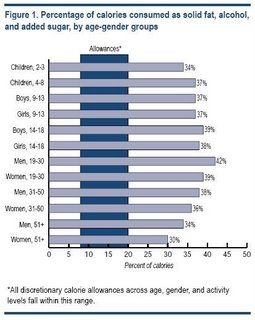An interesting report (.pdf) this month from USDA's Center for Nutrition Policy and Promotion approaches the limits of permitted boldness. The title emphasizes what to eat less: "Americans consume too many calories from solid fat, alcohol, and added sugar."
The revised Dietary Guidelines for Americans and the new MyPyramid graphic received some critical comment for introducing the concept of "discretionary calories." The idea is that, if you are an active person with high energy (calorie) needs, and you have already chosen enough healthy foods to meet your other nutrient needs, you might feel free to fill out the remainder of your energy needs with some treats. Most nutrition educators actually agree with the science behind this concept, I think, but many worried it would imply endorsement for all sorts of unhealthy foods. The real question was whether USDA's nutrition communicators would make clear the limits on the recommended amounts of these discretionary calories.
This month's report seems fairly clear. While recommended discretionary calories for certain age and gender groups might reach as high as 20 percent of all food energy, the accompanying graphic shows that American intake of unnecessary sugar, alcohol, and solid fats is vastly higher.
In keeping with the tradition of mentioning nutrients in an opaque way without criticizing particular foods, the report uses the bulky acronym SoFAAS to indicate solid fats, alcohol, and added sugars.
Beyond that acronym, would the report courageously mention particular foods to eat less? Well,... er,.... "Future research will focus on ... examining the sources of these calories, and applying the concept of SoFAAS to identify the nutrient density of various foods."

Source: USDA/CNPP.
